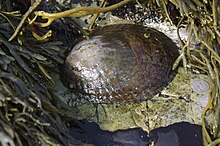Lottiidae
| Lottiidae | ||||||||||||
|---|---|---|---|---|---|---|---|---|---|---|---|---|

|
||||||||||||
| Systematics | ||||||||||||
|
||||||||||||
| Scientific name | ||||||||||||
| Lottiidae | ||||||||||||
| Gray , 1840 |
The Lottiidae are a family of marine snails found in cold to warm seas around the world. As grazers , they live on algae and lichen.
features
Turtle snails have a conical, bilaterally symmetrical shell without coils, which resembles the house of limpets . The apex is in the middle or slightly in front of it. The bowls are mainly sculptured radially from the tip to the edge. The inside of the bowl is porcelain-like and without a pearlescent sheen. The muscle attachment to the snail shell is horseshoe-shaped. Depending on the type, the body length of the adult animal varies from a few millimeters to 5 cm, only the largest species, which at the Pacific coast of North America living Lottia gigantea , reached 9 cm. The snails have no operculum.
The head has a strong snout. Eyes can be present or absent. The big foot is very strong. In contrast to the real limpets, there is a real gill in the mantle cavity of the Lottiidae .
The snails are hermaphrodites with external fertilization. The eggs develop over a short trochophora stage into free-swimming Veliger larvae, which after a longer pelagic phase metamorphose into small snails .
Way of life
The Lottiidae live on rocks in the intertidal zone and in deeper waters, where they suck on the rocky subsoil with their feet like a limpets and graze the growth with their radula . The snails are herbivores and feed on algae and lichen , which they scrape off with their powerful radula.
In the North Sea the family is represented by the turtle snail ( Testudinalia testudinalis ) and the virgin limpet ( Tectura virginea ).
Systematics
According to Nakano & Sasaki (2011), who carried out molecular genetic studies, the Lottiidae family is one of six families in the superfamily Lottioidea and eight families in the order Patellogastropoda. While Nakano & Ozawa (2007) grouped the Acmaeidae under the Lottiidae, they are now a separate family again. It should be noted, however, that the virgin limpet , for example, which was part of the Acmaeidae as Acmaea virginea before 2007 , is now part of the Lottiidae as Tectura virginea . Thus, quite new descriptions of the genus and family no longer fully apply.
The Lottiidae family includes 14 genera:
- Actinoleuca Oliver, 1926
- Asteracmea Oliver, 1926
- Atalacmea Iredale, 1915
- Discurria Lindberg, 1988
- Lottia Gray, 1833
- Nipponacmea Sasaki & Okutani, 1993
- Notoacmea Iredale, 1915
- Patelloida Quoy & Gaimard, 1834
- Potamacmaea Peile, 1922
- Radiacmea Iredale, 1915
- Scurria Gray, 1847
- Tectura Gray, 1847
- Testudinalia Moskalev, 1966
- Yayoiacmea Sasaki & Okutani, 1993
literature
- K. Janke, B. Kremer: Dune, Beach and Wadden Sea , Kosmos-Verlag, 1999, ISBN 3-440-07734-9
- T. Nakano, T. Sasaki (2011): Recent advances in molecular phylogeny, systematics and evolution of patellogastropod limpets . Journal of Molluscan Studies 77 (3), pp. 203-217. doi : 10.1093 / mollus / eyr016
- T. Nakano, T. Ozawa (2007): Worldwide phylogeography of limpets of the order Patellogastropoda: Molecular, morphological and palaeontological evidence . Journal of Molluscan Studies 73 (1), pp. 79-99. doi : 10.1093 / mollus / eym001
Web links
- Fischhaus Zepkow: Family Lottiidae
- Lottiidae . From: JM Poutiers: Gastropods . In: Kent E. Carpenter, Volker H. Niem (eds.): FAO Species identification guide for fishery purposes. The living marine resources of the Western Central Pacific. Volume 1: Seaweeds, corals, bivalves and gastropods. Food and Agriculture Organization of the United Nations, Rome 1998. pp. 390ff.
- ITIS report
- Animal Diversity Web
Individual evidence
- ↑ Marine Species Identification Portal: Acmaea virginea (Müller, 1776)
- ^ Marine Species Identification Portal: Acmaeidae Carpenter, 1857
- ↑ World Register of Marine Species , Acmaea virginea (Müller OF, 1776) , Tectura virginea (OF Müller, 1776) , Acmaeidae Forbes, 1850
- ^ World Register of Marine Species , Lottiidae Gray, 1840


